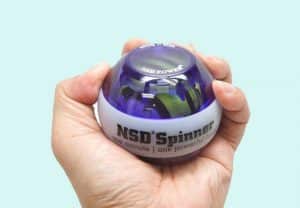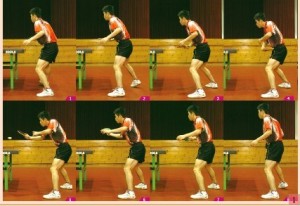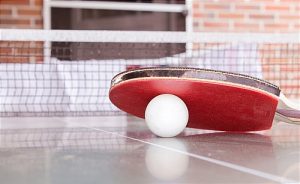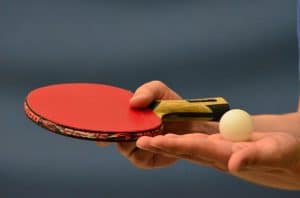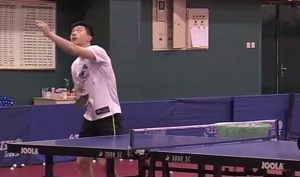As a Beginner, learning some easy table tennis serve is the first thing you should master for a start before you can learn any of the table tennis strokes.
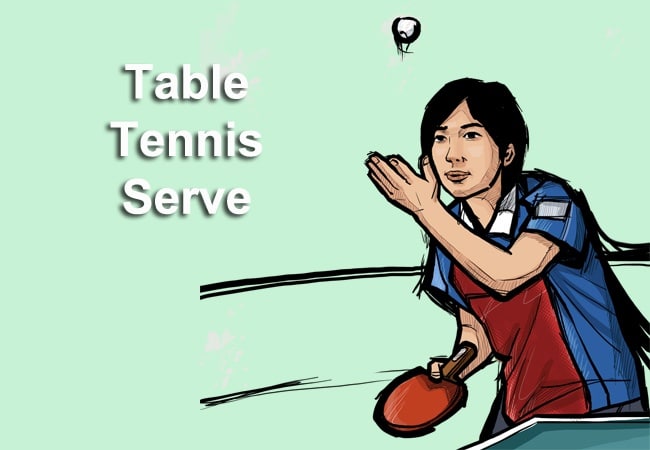
I will teach you four easy ways to serve table tennis that will be very useful for beginners. They are the Forehand topspin serves, and Backhand topspin serves, Forehand backspin serves and backhand backspin serves.
It is advisable to know how to serve before practising how to make topspin and backspin serves.
In case you do not know what topspin and backspin are or do not know their difference, visit the table tennis spin page.
Do you want to know what the rules say about service? Visit the rules of table tennis page.
If you do not know how to make legal table tennis, click here for details on making a good serve in table tennis.
Table of Contents
How to Make a Topspin Serve
Topspin serve
Topspin can be done using forehand or backhand, but you can stick to any style that fits you or more comfortable for you to do.
As a beginner, you should learn to do it slowly, but as you improve on serving table tennis, you can know to do it faster.
Forehand topspin serve
To play the forehand topspin serve, hold your table tennis racket vertically towards the floor; swing back a little as you toss the ball up.
Play the ball on the back towards the top with an upward and forward motion.
You will need to graze the ball for maximum topspin but do not graze it too much and always make sure it does not bounce off the table.
How to Make a Backspin Serve
Backspin Serve
The backspin serve can be done using both the forehand and backhand. It is always good to know how to use both when practicing the backspin serve.
Forehand backspin serve
To play the forehand backspin, hold your racket high toward your head as you toss the ball up then as the ball drops and bounces lean forward towards the table and hit the ball on the back towards the bottom with a downward stroke.
You should always hit the ball with maximum speed but do not hit it too much and always make sure that the table tennis ball does not bounce off the table.
Backhand backspin serve
Backhand backspin serves the same way as the forehand backspin, but the only difference is that it is played with the backhand stroke.
However, it is essential to practice and master how to play both the forehand and backhand backspin.
Tips on how to play the topspin and backspin serve
(1) Try as much as possible to keep the ball low when you make your serve so that your opponent does not have an opportunity to attack.
(2) Always make the right serve to avoid losing valuable points.
(3) Do not serve aimlessly; your entire serve should be aimed at a particular part of your opponent’s side of the table tennis table.
The Bottom Line…
The topspin and backspin serve are not too hard to master; it is the easiest table tennis serve to learn.
Now you know how to make legal table tennis serve using the topspin and backspin serve, your next step will be to learn some easy table tennis strokes.
Table Tennis Basic Serve Tips
Serving is essential to table tennis because it allows the game to start and determine how you will play and expect the ball to be hit back if they correct it.
Here are some basic rules that you must abide by in a real game:
- The ball must be held above the table so that the umpire and your opponent can see it.
- The ball must be on the palm with the fingers extended and tossed upwards to at least six inches.
- The ball must only be hit on the way down from the toss.
- The ball must be hit behind the end line.
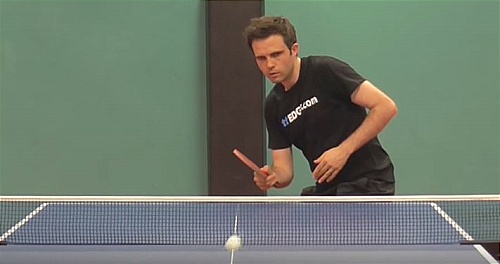
Topspin Serves
Forehand Topspin Serve
- Turn to your side to have a back leg, and your racket arm is your back arm.
- Hold the racket perpendicular to the table and have the ball on the palm of your other hand slightly in front and below the racket.
- Bring the racket back and gently toss the ball upwards, no higher than about eye level or you might lose control.
- Bring the racket forward and graze it upwards as you hit it.
- For more spin, hit it at a tilted upwards angle.
- For more speed, hit it without tilting your racket as much.
- Follow through to the opposite side of your body and return to a ready stance.
Backhand Topspin Serve
- Face the table and have the back of your racket facing your opponent.
- Hold the racket perpendicular to the table and have the ball on the palm of your other hand in front and below the racket.
- Bring the racket closer to your body and gently toss the ball upwards, at no higher than your eye level or you might lose control.
- Bring the racket forward with a slow flick of your wrist and graze the ball upwards as you hit it.
- Follow through by extending your arm to the other side of your body.
Backspin Serves
Forehand Backspin Serve
- Turn your body so that your side faces the table with your serving shoulder the farthest body part.
- Hold your racket parallel to the table with the ball lying on the palm of your other hand.
- Bring the racket back and gently toss the ball into the air, no higher than your eye level or about six inches high.
- Bring the racket forward in sideways slicing motion so you can graze the ball downwards.
- Follow through with your arm almost crossing over your body and then return to your ready stance.
Backhand Backspin Serve
- Stand facing the table.
- Hold the racket in front of your stomach and perpendicular to the table with the ball lying on the palm of your other hand.
- Bring the racket closer to your body and gently toss the ball into the air, no higher than your eyes or about six inches high.
- Bring the racket forward, tilted so that the top part is pointing at you, and slice downwards to hit and graze the ball so that there is a backspin.
- Follow through with your arm extended away from you and then return to your ready stance.
How to Serve in Ping Pong
Are you fond of watching table tennis games or tournaments? Then, you will be tempted to play the same sport. However, playing table tennis requires various considerations. It needs excellent speed and accuracy. Whether you are young or old, you can play this sport. It would help if you learned its essential serving tips and procedures.
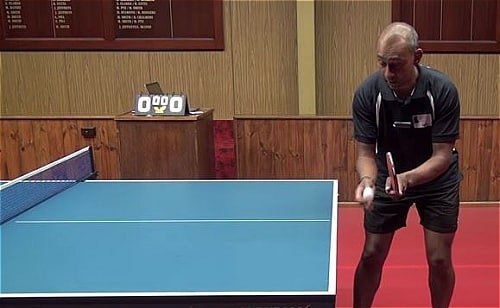
How to perform a good serve:
Table tennis is an easy game. Even young players can follow their exact steps. If you are planning to learn how to play table tennis, you are on the right track. Read this article, and you will know how it plays.
In table tennis, serving plays a vital role. It can dictate whether you win or lose the game. With its great significance, you should understand how to serve accurately. For your guide, here are the different tips provided by a professional table tennis player in the Spin New York:
Always Keep the Ball Low and Vary the Spin
If you want to win the game, you have to serve the ball low. Make sure that the ball is enough to clear the net. In case you serve with a high ball, your opponent can quickly attack it. Besides, it would help if you also used different types of spin.
These types of spins include sidespin, underspin, side-underspin, side-topspin, and no-spin. If you keep on practicing these spin types, your opponent might be confused.
Change the Speed and Anticipate the Return
As a table tennis player, you have to try short and long serves. These serving styles keep your opponent on their toes. Therefore, they don’t know what is coming. Say, for instance, if you start serving a long serve, your opponent will adjust their position to play long serve in a better way.
Also, you need to anticipate the return. As advised, understand remembering the usual ways that they serve is returned. It can help in knowing what to expect, and you can easily plan for it. It means that you are always ready with your opponent’s action.
Never Give Any Clue and Always Continue
If you want to beat your opponent, you should learn not to give any clue. Try not to let your body give away any hint on your serving styles. Above all, you have to practice every day. To become a professional table tennis player, you have to practice the different serving styles accurately. It would be best if you also enhanced your speed to win the game.
Aside from the above mentioned, you should also know how to deceive your opponent. You have to understand how to pull away after contact with the ball.
Grip Practice
Before you master the correct table serving strategy, you need to guarantee that you are using the right grip. Four basic table tennis strokes can significantly help in improving your table tennis serving. These strokes include the following:
The Stance
Just like other sports, stance plays a vital role in playing table tennis. You want your stance to be feet shoulder-width apart in this game, a foot away from the baseline and knees slightly bent.
It would help if you also faced your opponent side-on. This stance helps you in keeping you stable while serving the ball. It also helps in adding power into your serve.
Ball Toss
It is the most challenging part of table tennis. But, it is essential to know where you are going to toss the ball before serving. There are several ways on how to launch the ball.
First is slightly in front of your body. This adds power by leaning into your serve.
Second is slightly in front of your right or left.
Lastly, it is throwing the ball higher and quite close to your body. This can help in getting the right angle for the kick serve.
Racquet Motion and Contact
Your racquet requires a looping style until it reaches your back. Upon doing this, you want the ball to be at its peak point and if it is making its downward position; you have to toss your racquet to contact with the center.
Body Motion
It is also one of the vital movements of playing table tennis. If you opt to learn how to serve in tennis, you need to master your body motions. As advised, your stance should have you in a good position.
Based on the tips on how to improve your serving, you can easily say it is easy to beat your opponent and win the game. But, mastering these basic serving tips is not too fast and easy. It requires enough time and effort. So, make sure you spend enough time to practice the serving tip before playing.
With your ideas about the essential tips in table tennis serving, it is easy for you to get a high score. So, use these serving tips and expect that you will win the game.
Common Excuse
Many people make excuses about practicing because there are not enough practice partners or do not have the time. To solve both those problems, you take fifteen minutes out of your day to practice serves. You don’t need a practice partner, and it only takes fifteen minutes each time! Even every other day would be helpful.
Considering that serves take up about half the match, it is pretty vital. If you have good serves, you can win effortless points, but unfortunately, that advantage also applies to your opponent.
It is essential to avoid giving your opponent the perfect setup or even worse missing your serve in the game.
When you are alone, take the chance to develop new, innovative motions that may surprise your opponent! (Make sure the serves remain legal and visible to the opponent and umpire) Just try to make it a part of your daily practice, and after a few weeks, you and your opponents will be able to see results.
Serve Reception
1 – Read correctly the serve. Pay attention to:
a – Paddle motion at the contact point. Not before, not after contact point.
b – Server position.
c – What equipment is your opponent using.
d – Racket grip.
e – Height of ball contact.
f – Sound at contact.
g – Racket angle.
h – Wrist, elbow and shoulder action.
i – Height of toss. The direction of toss.
j – Ball deviation and flight before/after the 1st/2nd bounce on the table. You have to read at the top level to watch this only as everything else is masked or deceptive.
k – Point of ball contact (near the tip of the blade, middle, close to handlle…). As a rule of thumb, the closer to the tip, the spiny the serve.
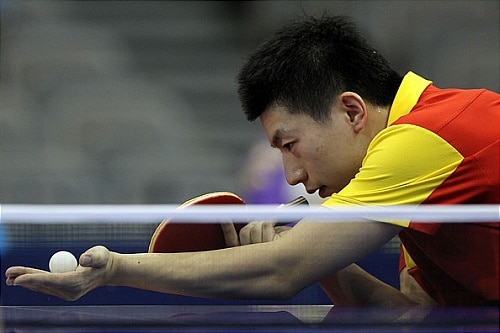
2 – Return serves for safety:
a – It’s better to return poorly than to miss a serve return.
b – Watch out for 2 bounce serves. Do not risk a point thinking ‘It will go off the table so that I can loop hard’.
c – Since your opponent is serving, he is more likely to control the game pace. Recover it from your serve return, or at least, reduce your opponent’s chances to start a strong attack.
d – Remember what happened in previous matches against the same opponent.
e – Let the ball bounce, to read its spin inspecting its flight.
f – Use incoming ball’s spin to your profit: Lots of players can’t handle his own best serves if they come spin-reversed or spin-continued (push with correct racket angle, so the ball keeps spinning).
3 – Your serve return should be:
a – Placed. Low. Spiny. Fast. Long or short.
b – Done with a purpose, don’t try to keep the ball in play. Use tactics.
c – Varied: Learn to flip, push with varied spins and loop against any spin.
d – Done with the decision: when you are sure of the spin on the ball, play your stroke of choice firmly. When you are confident, you can start to attack serves.
e – Done, so you gain the initiative. Control the rally since the beginning, or there will be no rally. Push it short and low, and your opponent will have to do a weak opening or push it back.
4 – Find your best ready position to serve reception, taking into account all sorts of things like:
a – Can you be surprised by a fast, short or angled serve?
b – Are you positioning too much forehand/backhand oriented? Are you covering the entire table?
c – Can you afford a weak return against your opponent?
d – How risky can you play? How’s the score?
e – Where should you place your returns? What are your opponent’s strengths?
f – What is your opponent’s serving position? Should I modify mine?
g – What were the previous serves?
h – It’s often better to receive a bit far from the table than closer, as you probably can move forward faster than backward.
i – Is my opponent a lefty?
With serves, do not assume that you ‘know how your opponent plays’, since the variation is much more significant than during rallying. Be ready for everything. A couple of tricky serves can make you lose the match.

Warren Davies


